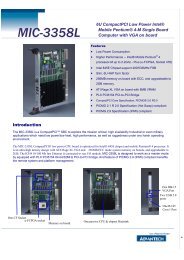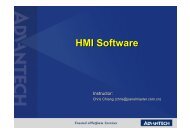industrial wireless book special edition - Networking ...
industrial wireless book special edition - Networking ...
industrial wireless book special edition - Networking ...
Create successful ePaper yourself
Turn your PDF publications into a flip-book with our unique Google optimized e-Paper software.
Lessons learned from IEEE802.11n Enterprise deployments<br />
l Because of MIMO, 802.11n RF propagation can significantly differ from traditional 802.11abg networks. An active<br />
site survey should always be done to test the RF characteristics of the environment prior to deployment.<br />
l Survey for at least two radios at all locations. Be sure at least one 2.4GHz and one 5GHz radio are visible from<br />
anywhere, and preferably, two 5GHz radios.<br />
l Use multi-radio arrays/APs so that large numbers of users do not have to share a single radio. Set the cell size so<br />
that a minimal number of users are at the fringe of the cell.<br />
l Do not create large cell size for an 802.11n design if you want to achieve the full performance 11n has to offer.<br />
l Don't assume a lower network device count when designing 802.11n networks. Design for high performance and<br />
plan support for legacy stations.<br />
l Use WPA2/AES encryption for 802.11n deployments; anything else is a compromise on security and performance.<br />
l Check the encryption performance of your <strong>wireless</strong> controllers and/or APs; many cannot handle the load and will<br />
become oversubscribed.<br />
l Legacy 802.11abg monitoring tools may not catch all of the threats for an 802.11n network. If the network is being<br />
migrated to 802.11n, the monitoring tools needs to be migrated as well.<br />
l 802.11n arrays/AP must be plugged into Gigabit Ethernet switch ports to take full advantage of the potental<br />
throughput improvement availble with 802.11n.<br />
l Minimize traffic load from 802.11n networks on the core by processing as much traffic as possible at the edge.<br />
l Be sure the core is capable of seeing an increase in data traffic from an 802.11n network.<br />
l A 5GHz Wi Fi network will be more resilient and higher performing than a 2.4GHz Wi Fi network will be. Every effort<br />
should be made to transition to 5GHz when deploying 802.11n.<br />
l Buy networking equipment that allows the radio operating frequency to be selected in software rather than fixed at<br />
a certain frequency.<br />
l When moving to 802.11n, don't expect to support more users per radio. The goal of deploying 11n should be to get<br />
more bandwidth per user. Because <strong>wireless</strong> is a shared medium, total performance of a radio will drop as more<br />
users are added.<br />
l In high density, high performance environments, using non-bonded 20MHz channels may improve overall<br />
performance.<br />
l Some clients may not operate properly with bonded channels. The network should be designed to handle these<br />
clients by turning bonding off on certain radios, or entirely.<br />
l 802.11b support should be turned off to improve 802.11n network performance if at all possible. Small numbers<br />
of 802.11b-only stations can be inexpensively upgraded to 802.11agn.<br />
l Test network adapters before making a purchasing decision. Throughput can vary greatly depending on the<br />
adapter and laptop configuration.<br />
l Check that <strong>wireless</strong> stations can connect to the specific channels being designed for use in the 802.11n network.<br />
l Be sure all network adapters are running the latest drivers for optimal frequency and radio selection.<br />
l If stations prefer 2.4GHz, it may be possible to coax them to 5GHz by doing some RF planning.<br />
l If stations stick to an array/AP for too long, performance may drop. Tweak the Roaming Aggressiveness to<br />
optimise roaming behaviour.<br />
l If possible, use the same NIC cards on all stations. At a minimum, use NICs with the same 802.11n feature set.<br />
array with a stronger signal. The level should<br />
not be too high, or the station will spend too<br />
much time associating to new arrays and not<br />
enough time sending traffic.<br />
Similar <strong>wireless</strong> NIC cards offering 802.11n<br />
and WPA2/AES encryption will improve network<br />
performance. Increasing the performance of as<br />
many stations as possible will have a<br />
tremendous affect on network performance.<br />
Conclusion<br />
To achieve a high performance network capable<br />
of replacing wired switches, a multi-radio, 5GHz<br />
802.11n Wi-Fi network will provide the best<br />
results. The overall network must be appropriately<br />
designed, from the supporting wired<br />
network, to <strong>wireless</strong> device placement, to the<br />
RF design. Stations should be capable of<br />
operating at 5GHz to take full advantage of<br />
802.11n functionality and achieve maximum<br />
performance.<br />
With a properly designed 802.11n Wi-Fi<br />
network, IT managers can deploy <strong>wireless</strong><br />
networks to replace wired networks. Existing<br />
wired network budgets can be re-allocated to<br />
<strong>wireless</strong> equipment that, with proper design,<br />
will deliver similar end-user experience, but<br />
with all the flexibility and mobility benefits<br />
that <strong>wireless</strong> brings.<br />
From the Xirrus Inc. white paper<br />
802.11n: Lessons Learned<br />
from the First 1000<br />
Installations<br />
http://j.mp/hiRtYx<br />
First published in the <strong>industrial</strong><br />
ethernet <strong>book</strong> April 2011<br />
sponsored by Advantech<br />
<strong>industrial</strong> ethernet <strong>book</strong><br />
13

















